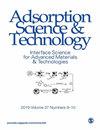La(III)和Y(III)在橘子皮上的吸附性能:实验变量、等温线和动力学的影响
IF 2.8
4区 工程技术
Q2 CHEMISTRY, APPLIED
引用次数: 10
摘要
为了缓解与稀土废水相关的环境问题,本研究应用废橙皮(OP)从水溶液中吸附La(III)和Y(III)。利用扫描电子显微镜(SEM)和傅立叶变换红外光谱(FTIR)对橙皮的吸附性能进行了表征,并验证了羟基和其他含氧基团的参与促进了物理化学相互作用。分批吸附结果表明,陈皮对La(III)和Y(III)具有良好的吸附性能。最佳吸附条件为pH为6,温度为40°C,适宜的吸附量为2 g/L和3 g/L,接触时间30 min,初始离子浓度为32 mg/L。在相同条件下,La(III)的吸附性能优于Y(III)。实验数据由Langmuir等温线模型拟合良好,具有相关性 系数 R2>0.9和最小标准误差值。平衡结果表明,La(III)和Y(III)在橘皮上的Langmuir单层吸附容量分别达到37.61和31.10 毫克/克。动力学拟合结果表明,La(III)和Y(III)的吸附过程符合拟二阶模型。因此,天然橙皮作为一种可回收的生物吸附剂,从水溶液中去除La(III)和Y(III)具有潜在的经济和应用效益。本文章由计算机程序翻译,如有差异,请以英文原文为准。
Adsorption Performance of La(III) and Y(III) on Orange Peel: Impact of Experimental Variables, Isotherms, and Kinetics
To alleviate the environmental problem associated with rare earth wastewater, this research applied waste orange peel (OP) for the adsorption of La(III) and Y(III) from aqueous solution. The adsorption properties of orange peel are characterized using scanning electron microscopy (SEM) and Fourier transform infrared spectroscopy (FTIR), and the participation of hydroxyl and other oxygen-containing groups that promote the physical-chemical interaction is verified. Batch adsorption results suggest that orange peel possesses a satisfactory adsorption performance for La(III) and Y(III). The optimal adsorption conditions were obtained at pH of 6, temperature of 40°C, appropriate dosage of 2 g/L and 3 g/L, contact time of 30 min, and initial ion concentration of 32 mg/L. Under the same condition, adsorption performance of La(III) is better than that of Y(III). The experimental data is well fitted by the Langmuir isotherm model with
correlation
coefficient
R
2
>
0.9
and the minimum standard error values. Equilibrium results show that Langmuir monolayer adsorption capacity of La(III) and Y(III) onto orange peel is up to 37.61 and 31.10 mg/g. The fitting results of kinetics prove that the adsorption process of La(III) and Y(III) follows the pseudosecond-order model. Thus, natural orange peel as a recyclable biosorbent has potential economic and applicative benefits to remove La(III) and Y(III) from aqueous solutions.
求助全文
通过发布文献求助,成功后即可免费获取论文全文。
去求助
来源期刊

Adsorption Science & Technology
工程技术-工程:化工
CiteScore
5.00
自引率
10.30%
发文量
181
审稿时长
4.5 months
期刊介绍:
Adsorption Science & Technology is a peer-reviewed, open access journal devoted to studies of adsorption and desorption phenomena, which publishes original research papers and critical review articles, with occasional special issues relating to particular topics and symposia.
 求助内容:
求助内容: 应助结果提醒方式:
应助结果提醒方式:


